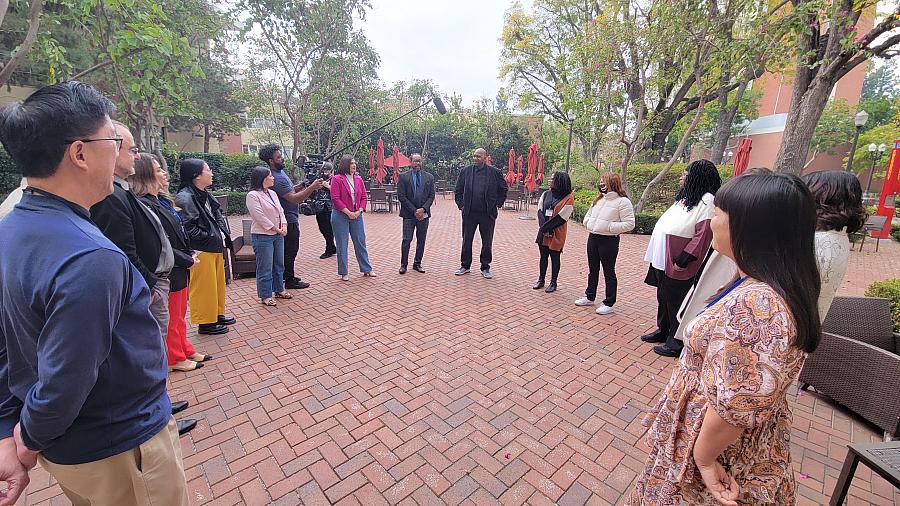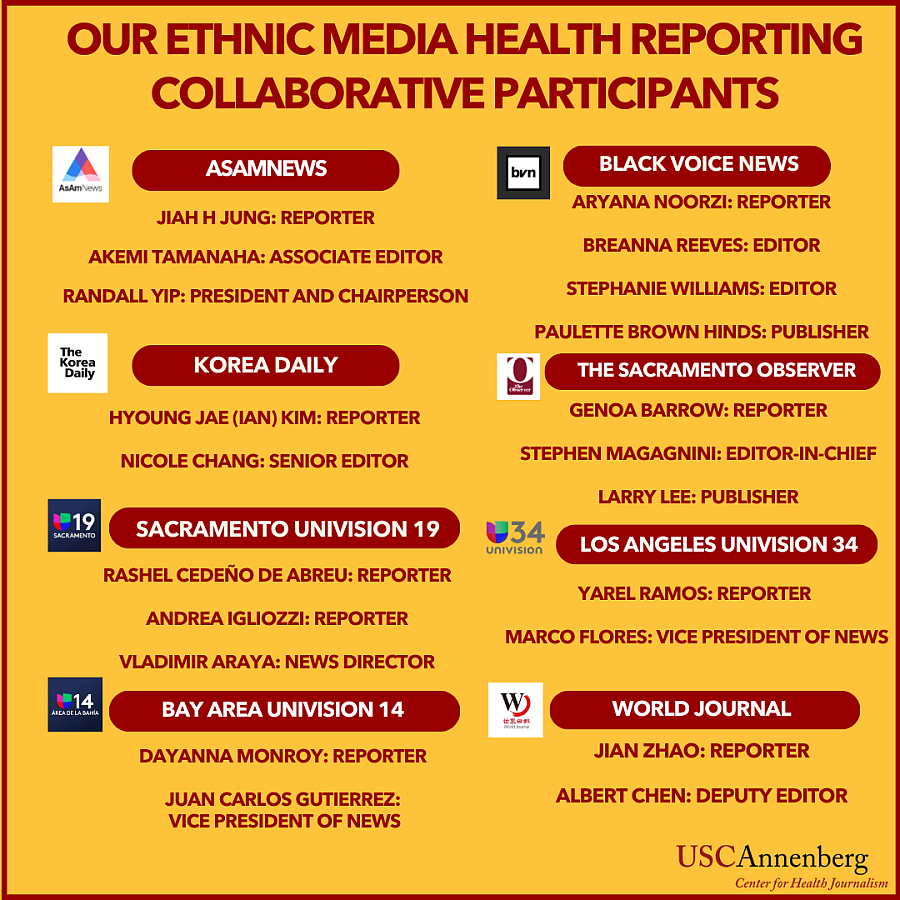A collaborative news effort aims to heal California’s health divide

The Ethnic Media News Collaborative participants take part in an ice-breaker during last week’s launch event.
(Photo by Teena Apeles/CHJ)
The USC Center for Health Journalism and partner newsrooms launched our first ethnic media collaborative last week, bringing together eight California outlets serving Black, Latino and Asian audiences. The news venture aims to reflect California’s potential without shying away from its health and equity challenges.
Last week, as a group of 19 journalists from around the state met at Wallis Annenberg Hall on the USC campus — news directors, editors and reporters — the conversation and coffee flowed freely as journalists discussed how newsrooms can help alleviate isolation and stigma around mental health, how to connect with community members using immersive approaches, and how to help mend the state’s health divide.
Participating outlets include three Univision affiliates (Univision 19, Sacramento, Univision 34, Los Angeles and Univision 14, Bay Area) that together reach a daily audience of 1 million; the Black-owned Sacramento Observer; Black Voice News in Riverside; World Journal, a leading Mandarin publication in Los Angeles; Korea Daily, also in Los Angeles, and AsAmNews, in the Bay Area.
The collaborative was made possible thanks to the generous support of the Blue Shield of California Foundation and the California Health Care Foundation. (In its second year, The California Endowment and The California Wellness Foundation also provided support).
Co-designing the Yearlong Collaborative
Participating outlets will spend a year collaborating with each other and with the Center for Health Journalism, producing rigorous, fact-based explanatory, narrative and investigative journalism that has the potential to bring about positive change. Under the collaborative's unique learning model, reporters will explore health themes the reporters, editors, news directors and publishers choose together, learning through a curriculum participating reporters and editors help design.
I’m excited and inspired by the opportunity to work with these talented journalists as we branch out with a new co-designed learning and reporting model.
The core reporting themes of the collaborative — selected by the eight outlets — will be mental health, aging, and the cascading effects of economic pressures, from losing housing to food insecurity. We’ll explore challenges and promising interventions, and the ways that these storylines play out for each community.
The venture is built on the belief that the state’s vibrant ethnic media is uniquely situated to chronicle the health circumstances of California’s diverse communities, sharing perspectives historically overlooked or often ignored by traditional media. As Breanna Reeves, a collaborative member with Black Voice News, put it: “Ethnic media has recognized that communities are the authorities of their own experiences and circumstances.”

Jia H. Jung, a reporter for AsAmNews and a collaborative member, said she valued the opportunity to be a part of a initiative that elevates ethnic media stories, looking forward to “putting our voices together in a united platform” and “having special in-person events that can bring in everyday people for community engagement and listening sessions. This could spark new connections within and between communities.”
The Center interviewed more than two dozen ethnic media reporters, news leaders and academics before launching the collaborative. Informed by their feedback and a scan of the ethnic media landscape, our USC Center recruited ethnic media outlets that reflect California’s diversity.
“In our work with ethnic and community-based news outlets around the state, we often hear that reporters and editors are stretched thin, finding little time for in-depth projects about health equity issues,” said Jenna Lane, communications officer at Blue Shield of California Foundation. “By supporting this reporting collaborative at the Center for Health Journalism, we hope to give those dedicated journalists more time and tools to serve their communities.”
"I couldn't be more excited about this new collaborative,” said Eric Antebi, chief communications officer of the California Health Care Foundation. “Ethnic media are vital to the wellbeing of California communities. That's why it is so important to invest in their capacity to report on the health issues facing the people they serve."
The Center brought in Jaya Padmanabhan, an award-winning journalist with decades of experience working in California’s ethnic media, to serve as the collaborative editor. Prior to joining the Center, she worked as an editor for Ethnic Media Services and India Currents, and as a columnist for the San Francisco Examiner, covering critical issues for communities of color. “I am enormously honored to be a part of the Center for Health Journalism ethnic media collaborative, a model that fosters cross-cultural sensitivity to health equity stories and promotes a sense of fellowship among diverse audiences in California,” Padmanabhan said.
This effort builds on the Center for Health Journalism’s history of launching and managing collaborative news ventures on health topics. It was a little more than 10 years ago when the USC Center for Health Journalism launched its first bilingual national collaborative, “Living in the Shadows,” on immigrant health. Another multiyear bilingual collaboration, “Just One Breath,” examined the consequences and potential remedies for valley fever. The series garnered praise in journalism circles and spurred millions in state public health and research investments. And in 2020, as the California legislature debated a historic expansion of Medicaid, the Center launched the bilingual collaborative “Uncovered California,” an exploration of the stories and policies needed to help the state’s uninsured.
For this collaborative, named “Healing California,” participating journalists have started reporting on a host of urgent mental health stories. You can find the collaborative's stories in the months to come at CenterforHealthJournalism.org and on the news pages and websites of participating outlets.
Take a look and share your feedback at editor@centerforhealthjournalism.org.

